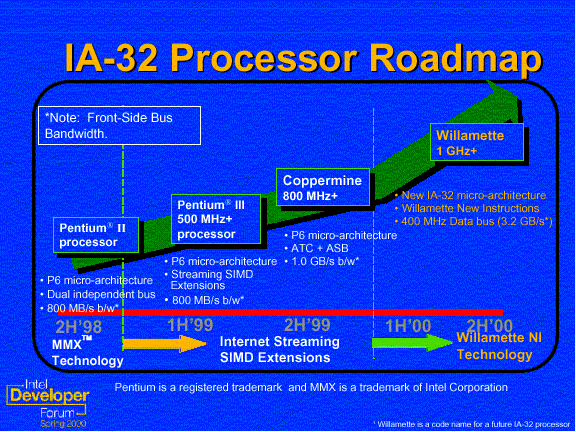Intel IDF Report #1 - CPUs
by Anand Lal Shimpi on February 15, 2000 2:29 PM EST- Posted in
- Trade Shows
The Willamette is going to be using a new bus which in protocol format is similar to the P6 bus, but the major advantage is its increased data transfer rate. Intel indicated that the bus would be operating at 400MHz, however this figure is most likely similar to the Athlon’s “200MHz” EV6 bus in that the bus actually operates at 100MHz but transfers data on both the rising and falling edges of the clock using a technology known to us by the familiar name of DDR. In the case of the Willamette, the bus will probably operate at 100MHz DDR while fetching twice as much data on the rising and falling edges of the clock. The other possibility is that the bus actually operates at 200MHz but it seems more logical for the FSB to run at 100MHz especially when you consider their recent announcement for a Quad Pumped Bus.

We were just recently informed that the chipset used for the Willamette will be the Tahema and it will be RDRAM-only. While this may definitely turn some users off of the Willamette, according to our sources, by the time that the Willamette hits the streets we should expect RDRAM to be much cheaper. Whether or not this wish will come true has yet to be seen, only time will tell.
The demo Intel showed consisted of little more than showing a 1.5GHz Willamette running their Frequency ID Utility which was extremely disappointing since they failed to even run any commonplace benchmarks on the system. We’ve been sitting here with a member of the Tom’s Hardware crew and we’ve been discussing the reasons behind Intel not even running any benchmarks on the setup, the main conclusion we’ve come to is that because of the nature of the CPU as a first revision silicon product it probably couldn’t run anything more than the frequency ID utility without sacrificing stability. Chances are that they didn’t want to demonstrate a 1.5GHz chip that would crash upon entering Winstone or SYSMark. If anything, they just wanted to show that they are on top of the clock speed battle, especially with AMD just recently shipping the 850MHz parts and their demonstration of a 1.1GHz Thunderbird.
We’ll have more Willamette information as the conference goes on.










0 Comments
View All Comments